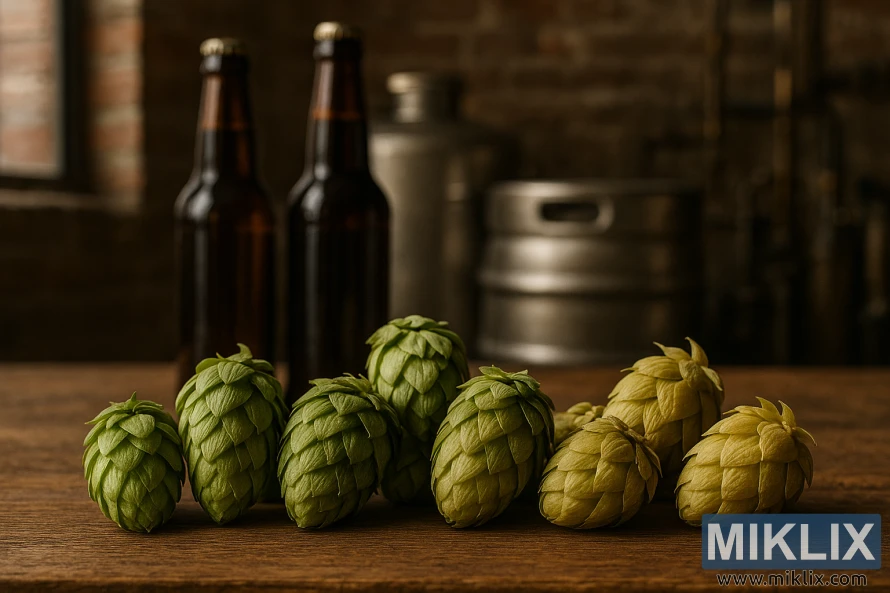Hops in Beer Brewing: Atlas
Published: August 30, 2025 at 8:56:23 AM UTC
Beer brewing is an art that requires a variety of ingredients. Hops, in particular, play a key role in defining the flavor and character of the final product. Atlas Hops have gained recognition for their unique attributes. Originating from Slovenia, Atlas Hops are a dual-purpose variety. They are valued for their moderate alpha acid content and distinct flavor profile. This makes them a versatile choice for brewers. Atlas Hops can be utilized in a range of beer styles, from pale ales to lagers. They offer a broad spectrum of brewing possibilities.

Key Takeaways
- Atlas Hops are a dual-purpose variety suitable for various beer styles.
- Their moderate alpha acid content contributes to a balanced flavor.
- Originating from Slovenia, they offer a unique flavor profile.
- Versatile in brewing, they can be used in pale ales and lagers.
- Ideal for brewers seeking to experiment with new flavors.
What Are Atlas Hops and Their Origin
In the 1970s, the Hop Research Institute in Zalec, Slovenia, introduced Atlas Hops to the brewing community. Atlas Hops, also known as Styrian Atlas, are a dual-purpose hop variety. They have gained recognition for their unique characteristics and moderate alpha acid content.
Originating from Slovenia, a country renowned for its hop production, Atlas Hops have become a significant variety in the brewing world. Slovenia's fertile soil and favorable climate contribute to the distinct flavor and aroma profiles of its hop varieties, including Atlas Hops.
Atlas Hops are characterized by their balanced properties, making them suitable for both bittering and flavor/aroma purposes in beer brewing. Their introduction in the 1970s marked an important development in hop cultivation. This offered brewers a versatile ingredient for various beer styles.
The development of Atlas Hops at the Hop Research Institute in Zalec highlights Slovenia's role in hop research and innovation. As a result, Atlas Hops have become an integral part of the brewing industry. They are appreciated for their quality and performance.
Understanding the origin and characteristics of Atlas Hops is essential for brewers looking to incorporate this variety into their recipes. By leveraging the unique properties of Atlas Hops, brewers can create beers with distinct flavor profiles. These appeal to a wide range of palates.
Chemical Composition of Atlas Hops
Understanding the chemical makeup of Atlas Hops is key for brewers aiming to craft the perfect beer. Atlas Hops boast an alpha acid range of 5% to 11%, and beta acids from 4% to 4%. This precise alpha to beta acid ratio is vital for achieving the right balance of bitterness and flavor stability in beer.
The alpha acids in Atlas Hops are the primary contributors to beer bitterness. With an alpha acid content of 5-11%, they offer a moderate to high bitterness level. In contrast, beta acids enhance the beer's flavor and aroma, with their effects becoming more pronounced over time.
Atlas Hops also contain essential oils and other minor compounds that shape the beer's character. These elements are responsible for the hop's aroma and can influence the beer's overall flavor profile.
The unique chemical profile of Atlas Hops makes them an excellent choice for a wide range of beer styles. By grasping the chemical composition of Atlas Hops, brewers can effectively use them to achieve their desired brewing goals.
Aroma and Flavor Profile
Atlas Hops stand out for their distinct aroma and flavor, key elements in beer brewing. Their intense aroma is marked by lime, floral, and pine notes. This creates a complex, inviting bouquet.
The flavor profile of Atlas Hops is equally complex. Lime notes introduce a bright, citrusy taste. Floral notes add a subtle, perfumy quality. Pine notes contribute a crisp, evergreen flavor, complementing various beer styles.
Using Atlas Hops adds depth and complexity to beer without dominating other ingredients. This makes them ideal for brewers aiming to craft nuanced, layered beers. Such beers showcase a variety of flavors.
The unique aroma and flavor of Atlas Hops enhance many beer styles. From pale ales and IPAs to lagers and pilsners, they add complexity and refreshment. Incorporating Atlas Hops into recipes allows brewers to create beers that are both complex and enjoyable.

Essential Brewing Characteristics
Grasping the key brewing traits of Atlas Hops is vital for brewers. Atlas Hops stand out as a versatile option, fitting seamlessly into all stages of brewing. They bring both bitterness and a rich flavor to the table.
The brewing characteristics of Atlas Hops include:
- Bitterness: Atlas Hops contribute a balanced bitterness to beer.
- Flavor: They add complex flavors, enriching the overall taste profile.
- Versatility: Suitable for various hop additions, from bittering to flavor and aroma.
Using Atlas Hops, brewers can anticipate a perfect blend of bitterness and flavor. These hops are highly regarded for their dual role in beer. They enhance both the bitterness and the flavor, making them a cornerstone in brewing.
- Balanced bitterness and flavor contributions.
- Versatility in brewing applications.
- Enhances the overall taste profile of beer.
By mastering these essential brewing characteristics, brewers can skillfully incorporate Atlas Hops into their recipes. This ensures the perfect balance of bitterness and flavor in their brews.
Alpha Acid Content and IBU Contribution
Atlas Hops boast an alpha acid content of 5-11%, positioning them for a moderate to high bittering role. This characteristic makes them ideal for a variety of beer styles. The alpha acid content is key in determining the hops' bittering impact, directly affecting the International Bitterness Unit (IBU) contribution.
The IBU contribution from Atlas Hops is notable, thanks to their alpha acid content. During brewing, these hops release alpha acids, which then isomerize. This process enhances the beer's bitterness. The final bitterness level is a result of the alpha acid content and brewing parameters, such as boil time and hop addition timing.
Breweries can fine-tune the bitterness by adjusting the Atlas Hops quantity and timing of addition. This adaptability positions Atlas Hops as a versatile choice for brewers seeking to craft beers with specific bitterness profiles.
In conclusion, Atlas Hops' alpha acid content and their IBU contribution make them a valuable asset in beer brewing. They offer a spectrum of bittering options for brewers.
Best Beer Styles for Atlas Hops
Atlas Hops are a versatile ingredient, perfect for elevating pale ales and lagers. Their unique flavor and aroma make them ideal for brewers aiming to innovate in these styles.
Atlas Hops are well-suited for a variety of beer styles. They shine in:
- Pale Ales: Atlas Hops add a complex hop character, boosting the beer's flavor and aroma.
- Lagers: The crisp, clean flavor of lagers is enhanced by Atlas Hops' subtle hop notes.
- India Pale Lagers (IPLs): A blend of IPA hoppy flavor and lager crispness, Atlas Hops are a perfect match.
When brewing with Atlas Hops, consider their alpha acid content. This will impact the beer's bitterness, flavor, and aroma.
To effectively use Atlas Hops in your brewing, follow these guidelines:
- Balance: Make sure the hop flavor and aroma are balanced with the malt character.
- Timing: Experiment with different hop addition times to achieve the desired flavor and bitterness.
- Pairing: Consider pairing Atlas Hops with other hop varieties for a complex and unique flavor profile.

Optimal Timing for Atlas Hops Addition
Timing is everything when it comes to Atlas Hops in brewing. The brewing stages are numerous, and the hop addition timing greatly influences the beer's taste and smell. This timing is critical for achieving the desired flavor and aroma.
The brewing process involves various hop additions at different stages. These include early boil, late boil, and dry hopping. Each stage has a unique role in shaping the beer's bitterness, flavor, and aroma.
- Early boil hop additions mainly contribute to bitterness.
- Late boil additions enhance flavor and aroma.
- Dry hopping extracts delicate aromas and flavors from hops.
For Atlas Hops, the best timing depends on the desired outcome. To use their alpha acid for bitterness, add them early in the boil. For flavor and aroma, late boil or dry hopping is better.
Brewing with Atlas Hops requires a balanced approach. Consider both the alpha acid content and the desired flavor and aroma profile. Experimenting with different timing strategies can help brewers achieve their desired beer characteristics.
Storage and Handling Requirements
To preserve the unique characteristics of Atlas Hops, brewers must adhere to specific storage and handling guidelines. Proper storage is critical in maintaining the quality and flavor profile of these hops.
Atlas Hops should be stored in a cool, dry environment, away from direct sunlight and heat sources. The ideal storage conditions include a temperature range between 32°F and 40°F (0°C and 4°C) and a relative humidity of less than 50%.
- Store Atlas Hops in airtight containers or vacuum-sealed bags to prevent exposure to air and moisture.
- Keep the storage area clean and free from contaminants to prevent spoilage.
- Label and date the stored hops for easy identification and rotation.
By following these storage and handling best practices, brewers can ensure that their Atlas Hops retain their quality. This contributes to the desired flavor and aroma in their beers.
Complementary Hop Varieties
Combining Atlas Hops with other varieties can lead to complex and intriguing beer flavors. This approach allows brewers to explore unique pairings, enriching their beers' overall character.
When choosing complementary hop varieties, brewers must consider the desired flavor and aroma profiles. For example, pairing Atlas Hops with citrusy hops like Citra or Amarillo can introduce a bright, citrusy note to the beer.
- Citra: Known for its citrus flavor and aroma, Citra hops add a vibrant character to beers.
- Amarillo: With its floral and citrus notes, Amarillo hops can enhance the complexity of beer flavors.
- Mosaic: Mosaic hops offer a range of flavors, including tropical fruit and earthy notes, making them a versatile pairing with Atlas Hops.
- Simcoe: Simcoe hops bring a piney and earthy character, which can complement the balanced profile of Atlas Hops.
By experimenting with different hop pairings, brewers can craft unique beer flavors that distinguish themselves in the market. The goal is to find a balance between each hop's characteristics, creating a harmonious blend.

Commercial Beers Featuring Atlas Hops
Atlas Hops have become a favorite among brewers, leading to their inclusion in several commercial beers. Breweries across the United States are exploring Atlas Hops to craft unique flavor profiles in various beer styles.
Pale ales and lagers are notable examples of beers that feature Atlas Hops. These beers highlight the hop's ability to enhance different brewing styles. For example, a pale ale with Atlas Hops might offer a balanced mix of citrus and floral notes. On the other hand, a lager could have a crisp, clean finish with subtle spice hints.
Many breweries showcase Atlas Hops in their beers. Some use it as a single-hop variety, while others blend it with other hops for complex flavors. The inclusion of Atlas Hops in commercial beers demonstrates its versatility and the innovation it brings to the brewing industry.
- Pale Ales: Showcasing citrus and floral notes
- Lagers: Displaying crisp finishes with subtle spice hints
- IPAs: Highlighting the hop's bittering and flavor contributions
As Atlas Hops' popularity grows, we can anticipate more commercial beers featuring this innovative hop. Whether used alone or in combination with other hops, Atlas Hops promise to add unique characteristics to a wide range of beer styles.
Common Brewing Challenges and Solutions
Atlas Hops bring unique traits to brewing, yet brewers face hurdles in achieving consistent flavor and aroma. These issues arise from the hop's chemical makeup and the brewing process itself.
Managing Atlas Hops' alpha acid content and beta acid profile is a major challenge. This affects the beer's bitterness and flavor. To tackle this, brewers can tweak the timing and quantity of hop additions.
- Monitor alpha acid content closely to adjust brewing parameters.
- Use a combination of early and late hop additions to balance bitterness and flavor.
- Store Atlas Hops properly to maintain their potency and freshness.
Flavor and aroma inconsistencies are also common. These can be due to hop storage, handling, and the brewing environment. Strict quality control measures can help address these issues.
Solutions to these challenges include:
- Regularly testing hop samples for alpha acid content and other relevant metrics.
- Adopting best practices for hop storage, such as freezing or refrigeration.
- Optimizing brewing techniques, including mash temperature, boil time, and fermentation conditions.
By understanding the common brewing challenges with Atlas Hops and implementing these solutions, brewers can achieve more consistent and desirable outcomes in their beers.
Recipe Development Guidelines
Recipe development with Atlas Hops requires careful consideration of several key factors. These factors significantly influence the final flavor and aroma of your beer.
Atlas Hops can be used in a variety of beer recipes, including pale ales and lagers. This versatility makes it an excellent ingredient for brewers looking to craft unique beers.
When developing recipes with Atlas Hops, it's essential to consider the hop's alpha acid content, aroma profile, and how it complements other ingredients. This ensures a balanced and harmonious flavor in your beer.
- Determine the desired flavor and aroma profile for your beer.
- Choose the appropriate amount of Atlas Hops based on their alpha acid content and your beer's IBU requirements.
- Consider the timing of hop additions to achieve the desired balance of bitterness, flavor, and aroma.
Atlas Hops can be used as a single hop variety or blended with other hops. This allows brewers to create complex and intriguing flavor profiles.
When using Atlas Hops in different beer styles, consider the following:
- Pale Ales: Use Atlas Hops for their balanced bitterness and citrus notes.
- Lagers: Utilize Atlas Hops for their crisp, clean flavor and aroma.
- Experiment with different hop combinations to create unique beer recipes.

Quality Assessment Methods
To achieve optimal brewing results, assessing the quality of Atlas Hops is essential. The quality of these hops directly influences the beer's flavor and aroma. This, in turn, affects the final product's taste.
Several methods are used to evaluate Atlas Hops quality. These include sensory evaluation and chemical analysis. Sensory evaluation focuses on the hop's aroma and flavor. Chemical analysis, on the other hand, examines the hop's chemical makeup.
Sensory evaluation is a critical step in assessing Atlas Hops quality. It involves:
- Evaluating the aroma characteristics, such as floral, fruity, or herbal notes.
- Assessing the flavor profile, including any bitterness or aftertaste.
- Checking for any off-flavors or defects.
Chemical analysis, in contrast, examines the hop's chemical composition. This includes:
- Alpha acid content, which contributes to the beer's bitterness.
- Beta acid content, which affects the hop's stability and storage characteristics.
- Essential oils, which are responsible for the hop's aroma and flavor.
Combining sensory evaluation and chemical analysis offers a complete understanding of Atlas Hops quality.
By using these methods, brewers can ensure their Atlas Hops meet brewing standards. Regular assessments help identify any issues early. This allows for timely adjustments in the brewing process.
Sustainability and Environmental Impact
Atlas Hops play a key role in beer's flavor and bitterness. Yet, their production has a notable environmental impact. The process requires a lot of water and energy, leading to a significant environmental footprint.
The hop production journey affects the environment at various stages. Farming, harvesting, and processing all have their own environmental costs. Water usage is a major concern during farming, where irrigation is essential for hop growth.
To lessen the environmental burden of Atlas Hops, breweries and farmers can embrace sustainable practices. They can use rainwater collection systems, invest in energy-efficient equipment, and refine farming methods to cut down on waste.
Some effective strategies for sustainable hop production include:
- Implementing drip irrigation to reduce water waste
- Using renewable energy sources for drying and processing hops
- Adopting integrated pest management practices to minimize chemical use
By implementing these strategies, the environmental impact of Atlas Hops can be greatly diminished. This contributes to a more sustainable brewing industry.
Conclusion
Atlas Hops have become a key player in the brewing world. They bring a unique flavor and aroma to various beer styles. For brewers, grasping the essence of Atlas Hops is vital for creating outstanding beers.
The unique chemical makeup and alpha acid content of Atlas Hops make them versatile. By mastering when to add them and how to store and handle them, brewers can fully realize their benefits.
The brewing industry is shifting towards sustainability, and hop cultivation's environmental impact is critical. Choosing hops like Atlas Hops, grown sustainably, helps brewers contribute to a greener brewing process.
Integrating Atlas Hops into your brewing can be incredibly rewarding. It adds a new layer to your beers, enriching your brewing journey.
Further Reading
If you enjoyed this post, you may also like these suggestions:
